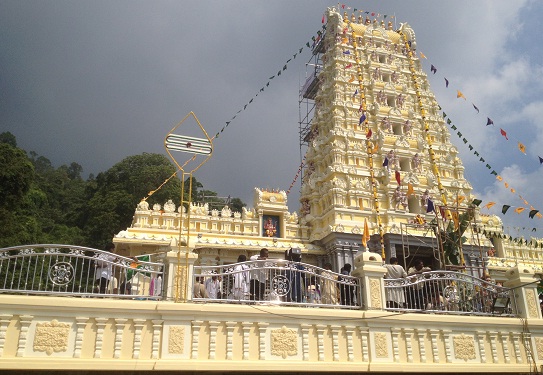
Oldest Hindu Temple in Penang
The Balathandayuthapani Temple, officially the Arulmigu Balathandayuthapani Kovil, and better known as the Waterfall Hill Temple or Hill Top Murugan Temple, is one of the oldest Hindu temple in Penang. It was originally located within the grounds of the Penang Botanical Gardens.
According to popular belief, a sadhu (holy man) chose a spot close to the waterfalls for a shrine dedicated to Murugan. The place was called thanner malai, meaning water hill and the deity itself was known as Thannermalaian or “he who resides by the waterfall”.
This original site is as old as the founding of George Town itself. It was the site of the Balathandayuthapani temple until 1850, when the authorities took over the area to establish the Botanic Gardens Reservoir. That was when the temple moved out, leaving at its original site a small shrine.
After the authorities took over the site of the original Balathandayuthapani Temple, the temple was provided with a new eleven-acre hillside plot on the left side of the Botanic Gardens Road. The temple grew to become the focus of the annual Thaipusam celebrations.
At the foot of the staircase leading to the Balathandayuthapani temple is a shrine dedicated to the deity Ganesha. The Sree Ganeshar Temple has since developed into a separate temple in its own right and with its own devotees.
The Balathandayuthapani temple has undergone several major renovations. This is in keeping with the requirements of the Hindu religious tenets, that renovations be done for every mamangam, or 12-year cycle.
Over the years, as the number of devotees and worshippers increased, the Hindu Endowments Board found that the hilltop temple could no longer accommodate the numbers. This is especially true in the past decade, with more and more visitors converging on the temple particularly during the Thaipusam celebration (other feast days of smaller scale include the Chitra Pournami, Kantha Sasthi, Thirukarthigai and Aadipournami).
A feasibility study was conducted to ascertain the viability of expanding the old hilltop temple. Consultants engaged in the study discovered that the temple was sited over several subterranean springs. This makes its location unstable. After deliberating over the various reports, the Hindu Endowments Board made a decision to relocate the Balathandayuthapani temple to a new, safer location.
The new Arulmigu Balathandayuthapani temple is planned to accommodate up to 700,000 visitors, a number expected for every Thaipusam Festival. In keeping with its position as a major Hindu temple, it will have a huge maha mandapam, the pillared outer hall in which public rituals are performed.
Visitors to the new Arulmigu Balathandayuthapani Temple has an even longer climb than before but the view makes the effort worthwhile. With over 500 steps (some estimates put the figure at 512 steps, though this is difficult to judge, as there are more than one route to the top), it is longer than the 272 steps of Batu Caves. The winding route allows you to stop several times to enjoy the scenery.
Half way to the top, you arrive at the Old Hill Top Murugan Temple, the former site for the Thaipusam celebrations. Next to it is the Arulmamani Arumugam Pillai Mandapam, a pavilion built in 1956. It acts as the staging area for visitors and pilgrims. From here, you get a good view of the new Arulmigu Balathandayuthapani Temple before you continue your ascend. As you climb higher, the skyscrapers of Gurney Drive and eventually the rest of George Town come into view.
Arriving at the top, you enter the temple through a main gate topped by a gigantic seven-storey rajagopuram or kingly temple tower, which is intricately embellished with multi-tier statues of deities. The maha mandapam surrounds the garbhagriha or sanctum sanctorum, where the image of Murugan is placed. There is also alcoves or shrines for other deities.
The maha mandapam is supported by rows of intricately carved pillars. Hanging down from the ceiling are chandeliars that cast their light over the well-polished floor. Devotees gather in groups on the floor or awaiting their turn to perform prayers and rituals.
Since its recent expansion, the Balathandayuthapani Temple has become one of Penang’s major tourist attractions and not just during the Thaipusam season.
The temple pillars feature the 14th and 15th century architectural styles of Chola and Padya temple designs. These are executed by artisans specially brought in from India.
An additional 22 toilets are being built to supplement the existing forty in the temple grounds, as the temple is expected to receive thousands of devotees and sightseeing visitors.
No comments:
Post a Comment